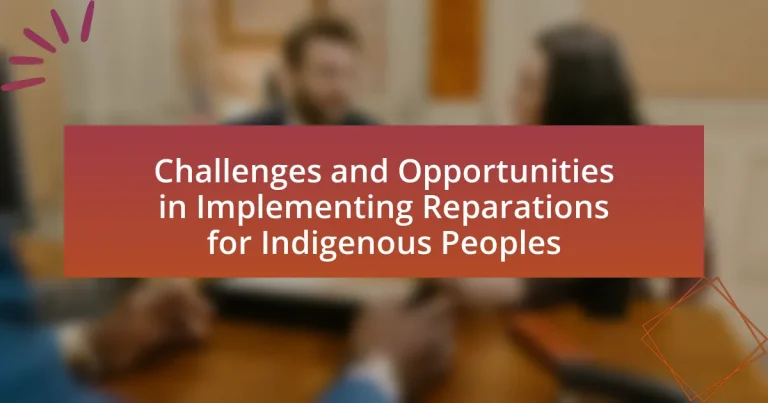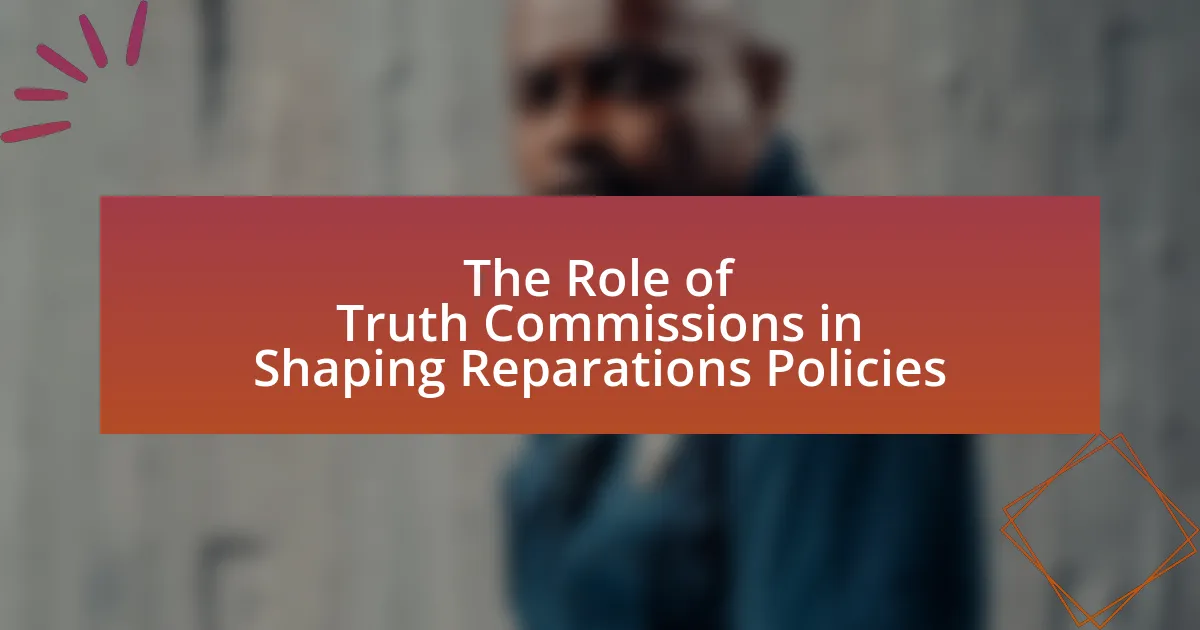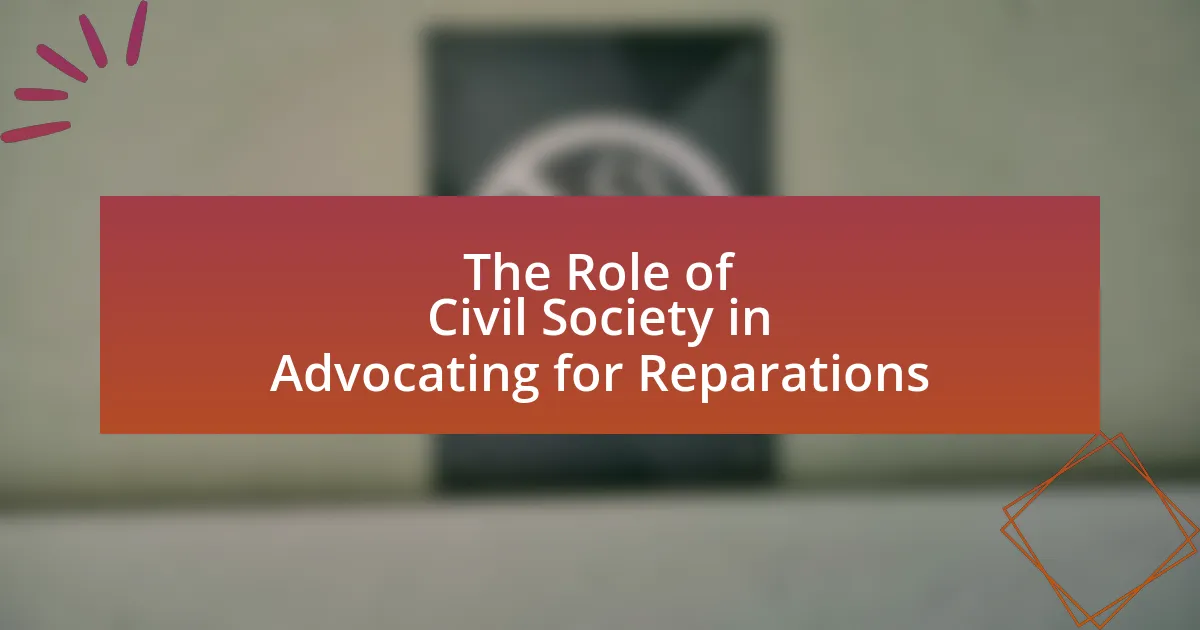The article examines the challenges and opportunities in implementing reparations for Indigenous Peoples, focusing on legal complexities, political resistance, and the necessity for historical acknowledgment. It highlights how historical injustices, such as colonization and systemic discrimination, impact current reparations efforts and public perception. The article also discusses the role of political institutions, socioeconomic barriers, and the importance of community engagement in shaping effective reparations initiatives. Additionally, it outlines best practices and frameworks for reparations, emphasizing the need for culturally sensitive approaches that address the unique needs of different Indigenous groups.
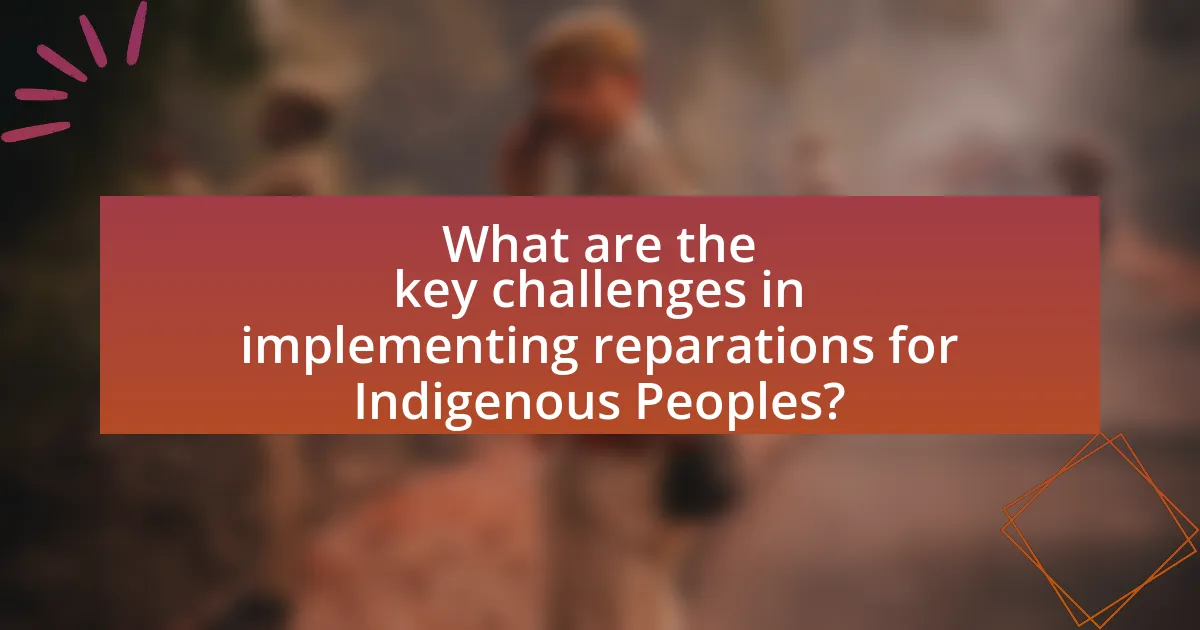
What are the key challenges in implementing reparations for Indigenous Peoples?
The key challenges in implementing reparations for Indigenous Peoples include legal complexities, political resistance, and the need for comprehensive historical acknowledgment. Legal complexities arise from the lack of clear frameworks for reparations, as existing laws often do not adequately address the unique historical injustices faced by Indigenous communities. Political resistance is frequently encountered from governments and institutions that may be reluctant to allocate resources or admit culpability for past actions. Additionally, achieving a comprehensive acknowledgment of historical injustices is essential, as many reparations efforts fail to address the full scope of harm inflicted on Indigenous Peoples, including cultural, social, and economic impacts. These challenges hinder the effective implementation of reparations and require targeted strategies to overcome them.
How do historical injustices impact current reparations efforts?
Historical injustices significantly hinder current reparations efforts by creating deep-seated mistrust and complicating the acknowledgment of past wrongs. For instance, the legacy of colonization and systemic discrimination against Indigenous peoples has led to ongoing socio-economic disparities, which complicate the negotiation of reparations. According to the United Nations Declaration on the Rights of Indigenous Peoples, recognition of historical injustices is essential for fostering reconciliation and establishing a framework for reparations. Furthermore, studies indicate that reparations are often met with resistance due to differing perceptions of justice and entitlement among various stakeholders, which can stall progress.
What specific historical events have led to the need for reparations?
The specific historical events that have led to the need for reparations include the colonization of Indigenous lands, forced removal from ancestral territories, and systemic discrimination against Indigenous peoples. The colonization process, marked by events such as the arrival of European settlers in the Americas, resulted in the seizure of land and resources, leading to significant cultural and economic dislocation for Indigenous communities. Additionally, policies like the Indian Removal Act of 1830 in the United States forcibly displaced thousands of Indigenous people from their homelands, causing loss of life and cultural heritage. Systemic discrimination, including the establishment of residential schools aimed at assimilating Indigenous children, further perpetuated trauma and loss of identity. These events collectively underscore the historical injustices that necessitate reparations for Indigenous peoples.
How do these historical injustices shape public perception of reparations?
Historical injustices significantly shape public perception of reparations by creating a context of awareness and empathy regarding the suffering of affected communities. For instance, the legacy of colonization, forced removals, and cultural erasure experienced by Indigenous peoples has led to a growing recognition of the need for reparative justice. This recognition is often influenced by educational initiatives, media representation, and advocacy efforts that highlight the historical context and ongoing impacts of these injustices. Research indicates that public support for reparations increases when individuals are informed about specific historical injustices, such as the residential school system in Canada, which forcibly assimilated Indigenous children and resulted in long-term trauma. Consequently, as awareness of these injustices rises, so does the perceived legitimacy of reparations as a necessary step toward healing and reconciliation.
What legal and political obstacles exist in the reparations process?
Legal and political obstacles in the reparations process include the lack of legal frameworks to support claims, political resistance from government entities, and the challenge of establishing a clear connection between historical injustices and current beneficiaries. Many countries lack specific laws that recognize the rights of Indigenous peoples to reparations, making it difficult to pursue claims in court. Additionally, political entities may oppose reparations due to concerns about financial implications or the potential for social unrest, as seen in various legislative debates. Furthermore, proving direct lineage or impact from historical injustices complicates the reparations process, as it requires extensive documentation and acknowledgment of past wrongs, which some governments are reluctant to address.
How do existing laws affect the implementation of reparations?
Existing laws significantly impact the implementation of reparations by establishing the legal framework within which claims can be made and addressed. For instance, laws related to property rights, land use, and historical injustices can either facilitate or hinder the process of providing reparations to Indigenous Peoples. In the United States, the Indian Claims Commission Act of 1946 allowed tribes to seek compensation for land taken without consent, yet many claims remain unresolved due to legal complexities and limitations imposed by existing statutes. Additionally, international laws, such as the United Nations Declaration on the Rights of Indigenous Peoples, provide guidelines for reparations but lack enforceability, which complicates their implementation. Thus, the interplay of domestic and international laws shapes the feasibility and effectiveness of reparations initiatives.
What role do political institutions play in facilitating or hindering reparations?
Political institutions significantly influence the process of reparations by either facilitating or hindering their implementation. These institutions, including governments and legal systems, can create frameworks that support reparative measures, such as legislation that acknowledges historical injustices and allocates resources for reparations. For instance, in Canada, the Truth and Reconciliation Commission led to governmental commitments for reparations to Indigenous peoples, demonstrating how political will can drive reparative actions.
Conversely, political institutions can also obstruct reparations through bureaucratic inertia, lack of political will, or policies that prioritize other interests over reparative justice. In the United States, for example, efforts to implement reparations for African Americans have faced significant political resistance, with legislative proposals often stalled or dismissed, illustrating how institutional barriers can hinder progress. Thus, the role of political institutions is crucial in shaping the landscape for reparations, determining whether they are effectively pursued or impeded.
What social and economic barriers affect Indigenous communities in accessing reparations?
Indigenous communities face significant social and economic barriers in accessing reparations, primarily due to systemic discrimination, poverty, and lack of political representation. Systemic discrimination manifests in policies and practices that marginalize Indigenous voices, limiting their ability to advocate for reparations effectively. Economically, many Indigenous communities experience high rates of poverty, which restricts their access to legal resources and information necessary to pursue reparations claims. Furthermore, inadequate political representation in government institutions hampers their ability to influence reparative policies. According to a report by the United Nations, Indigenous peoples are disproportionately affected by poverty, with many living below the national poverty line, which further complicates their efforts to secure reparations.
How do socioeconomic disparities influence the effectiveness of reparations?
Socioeconomic disparities significantly hinder the effectiveness of reparations by perpetuating unequal access to resources and opportunities among affected communities. When reparations are implemented, individuals from lower socioeconomic backgrounds often face barriers such as inadequate education, limited job prospects, and insufficient healthcare, which can diminish the intended benefits of reparations. For instance, a study by the Institute for Policy Studies found that wealth disparities among racial and ethnic groups in the United States are stark, with Black families holding only a fraction of the wealth of white families, which illustrates how systemic inequities can undermine reparative efforts. Thus, without addressing these underlying socioeconomic disparities, the impact of reparations may be severely limited, failing to achieve true equity and justice for Indigenous peoples.
What are the challenges in ensuring equitable distribution of reparations?
The challenges in ensuring equitable distribution of reparations include identifying eligible recipients, determining the appropriate form and amount of reparations, and addressing historical injustices that vary among different Indigenous groups. Identifying eligible recipients is complicated by the lack of comprehensive records and the diverse experiences of Indigenous peoples, which can lead to disputes over who qualifies for reparations. Additionally, determining the appropriate form—whether financial compensation, land restitution, or cultural preservation—requires careful consideration of the unique needs and circumstances of each community. Historical injustices, such as forced displacement and cultural erasure, further complicate the process, as different groups may have experienced varying degrees of harm and loss. These factors create significant barriers to achieving a fair and just distribution of reparations.
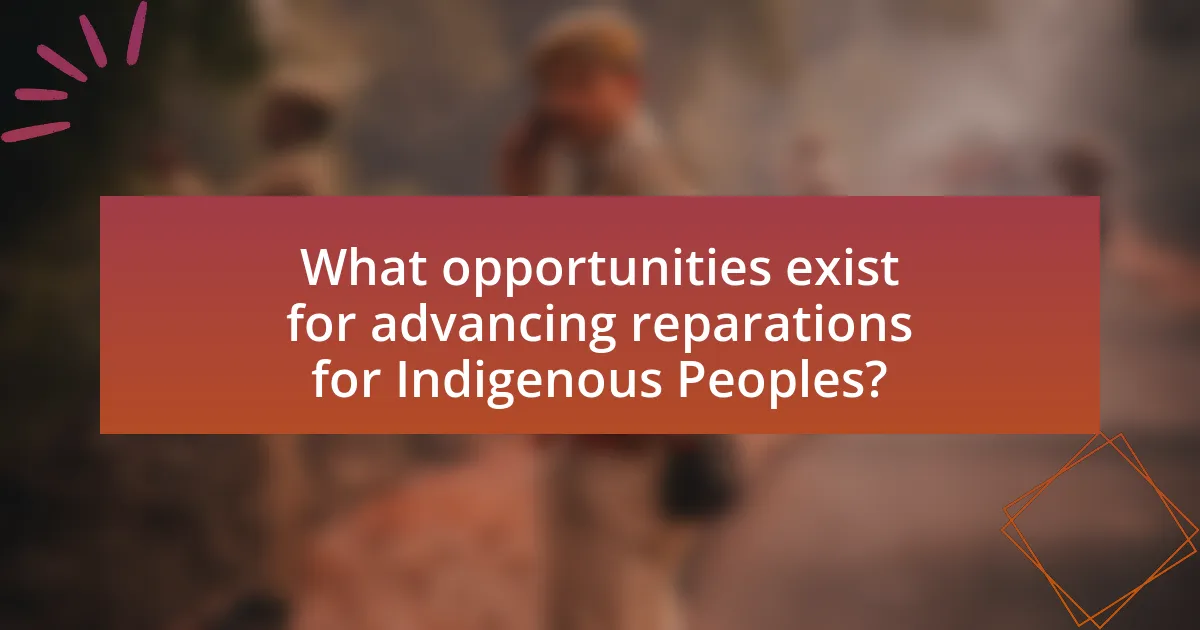
What opportunities exist for advancing reparations for Indigenous Peoples?
Opportunities for advancing reparations for Indigenous Peoples include legislative initiatives, public awareness campaigns, and partnerships with Indigenous organizations. Legislative initiatives, such as the introduction of bills aimed at recognizing Indigenous land rights and providing financial compensation, can create a formal framework for reparations. Public awareness campaigns can educate the broader population about historical injustices faced by Indigenous communities, fostering support for reparative measures. Additionally, partnerships with Indigenous organizations can ensure that reparations are designed and implemented in ways that align with the needs and desires of Indigenous Peoples, as seen in successful models like the Truth and Reconciliation Commission in Canada, which highlighted the importance of community involvement in reparative processes.
How can community engagement enhance reparations initiatives?
Community engagement can enhance reparations initiatives by fostering trust, ensuring inclusivity, and facilitating the identification of specific needs within affected communities. Engaging community members allows for a more accurate understanding of historical injustices and current disparities, which can inform the design of reparations programs. For instance, the 2016 report by the U.S. Commission on Civil Rights highlighted that community involvement is crucial for effective policy-making, as it leads to solutions that are more relevant and accepted by those directly impacted. Additionally, participatory approaches can empower communities, giving them a voice in the reparations process, which can lead to greater accountability and transparency in the implementation of initiatives.
What strategies can be employed to involve Indigenous voices in the reparations process?
To involve Indigenous voices in the reparations process, strategies such as establishing inclusive consultation frameworks, ensuring representation in decision-making bodies, and integrating Indigenous knowledge systems are essential. Inclusive consultation frameworks allow Indigenous communities to express their needs and perspectives, fostering a sense of ownership in the reparations process. Ensuring representation in decision-making bodies guarantees that Indigenous leaders and community members have a direct influence on policies affecting them. Integrating Indigenous knowledge systems respects cultural practices and historical contexts, which can lead to more effective and meaningful reparations. These strategies are supported by successful examples in various countries where Indigenous participation has led to more equitable outcomes in reparations initiatives.
How does community involvement impact the success of reparations programs?
Community involvement significantly enhances the success of reparations programs by fostering trust, ensuring cultural relevance, and promoting accountability. Engaging local communities allows for the identification of specific needs and priorities, which leads to tailored solutions that resonate with the affected populations. For instance, programs that incorporate community feedback have shown higher participation rates and satisfaction levels, as evidenced by the reparations initiatives in South Africa, where community-led discussions shaped the distribution of funds and resources. This participatory approach not only empowers communities but also increases the likelihood of sustainable outcomes, as seen in various case studies where active involvement led to more effective implementation and long-term benefits.
What role does education play in promoting understanding of reparations?
Education plays a crucial role in promoting understanding of reparations by providing individuals with the historical context and social implications of injustices faced by marginalized communities. Through curricula that include the history of colonization, systemic discrimination, and the ongoing impacts of these injustices, education fosters awareness and empathy among students. For instance, studies have shown that educational programs focused on Indigenous history and rights can significantly increase students’ understanding of the need for reparations, as evidenced by initiatives in various school districts that have led to greater community engagement and advocacy for policy changes. By equipping learners with knowledge about the past and present injustices, education serves as a foundational tool for advocating reparative justice.
How can educational programs raise awareness about Indigenous rights and reparations?
Educational programs can raise awareness about Indigenous rights and reparations by integrating Indigenous history, culture, and contemporary issues into curricula. This approach fosters understanding and empathy among students, highlighting the historical injustices faced by Indigenous peoples, such as land dispossession and cultural erasure. For instance, programs that include the Truth and Reconciliation Commission’s Calls to Action in Canada emphasize the need for reparative measures and educate students on the importance of acknowledging past wrongs. Additionally, partnerships with Indigenous communities can provide authentic perspectives and resources, ensuring that the content is accurate and respectful. Research indicates that educational initiatives that involve Indigenous voices lead to greater awareness and advocacy for Indigenous rights, as seen in programs developed by organizations like the National Indian Education Association.
What are effective methods for educating the broader public on this issue?
Effective methods for educating the broader public on the issue of reparations for Indigenous Peoples include community engagement initiatives, educational campaigns, and the use of digital platforms. Community engagement initiatives, such as workshops and town hall meetings, foster direct dialogue between Indigenous communities and the public, allowing for personal stories and historical context to be shared. Educational campaigns, including school curricula that incorporate Indigenous history and perspectives, can raise awareness from a young age. Additionally, digital platforms, such as social media and online webinars, can reach a wider audience, disseminating information quickly and effectively. Research indicates that these methods can significantly enhance public understanding and support for reparative justice initiatives, as evidenced by successful campaigns in various regions advocating for Indigenous rights and recognition.
How can partnerships between governments and Indigenous organizations facilitate reparations?
Partnerships between governments and Indigenous organizations can facilitate reparations by creating collaborative frameworks that ensure the needs and rights of Indigenous communities are prioritized. These partnerships enable the co-design of reparative measures, ensuring that policies are culturally relevant and effectively address historical injustices. For instance, the Truth and Reconciliation Commission in Canada highlighted the importance of Indigenous-led initiatives in shaping reparations, demonstrating that when Indigenous voices are included, the outcomes are more likely to be accepted and effective. Additionally, such partnerships can leverage governmental resources and expertise while fostering trust and accountability, which are essential for meaningful reparations.
What models of collaboration have proven successful in other contexts?
Successful models of collaboration in other contexts include participatory governance, public-private partnerships, and community-based approaches. Participatory governance, as seen in the case of the Philippines, has empowered local communities by involving them in decision-making processes, leading to more effective resource management and social equity. Public-private partnerships, exemplified by the collaboration between the government and NGOs in Brazil for environmental conservation, have facilitated shared resources and expertise, resulting in sustainable development outcomes. Community-based approaches, such as those implemented in New Zealand for Maori land rights, have fostered trust and mutual respect, enabling effective negotiation and implementation of reparative measures. These models demonstrate that inclusive and cooperative frameworks can yield positive results in addressing complex social issues.
How can these partnerships address the unique needs of Indigenous communities?
Partnerships can address the unique needs of Indigenous communities by fostering collaboration that prioritizes cultural preservation, economic development, and social justice. These partnerships can facilitate access to resources and funding tailored to the specific historical and contemporary challenges faced by Indigenous peoples, such as land rights and health disparities. For instance, initiatives like the United Nations Declaration on the Rights of Indigenous Peoples emphasize the importance of self-determination and community-led development, which can be effectively supported through strategic partnerships. Additionally, research indicates that collaborative efforts between Indigenous communities and governmental or non-governmental organizations can lead to improved educational outcomes and health services, thereby directly addressing the unique needs of these populations.

What are the best practices for implementing reparations for Indigenous Peoples?
The best practices for implementing reparations for Indigenous Peoples include recognizing their sovereignty, engaging in meaningful consultation, and providing financial compensation alongside land restitution. Recognizing sovereignty acknowledges Indigenous Peoples’ rights to self-determination and governance, which is essential for any reparative framework. Meaningful consultation ensures that Indigenous communities are actively involved in the decision-making processes that affect them, fostering trust and collaboration. Financial compensation, when paired with land restitution, addresses historical injustices and supports community development. For instance, the Truth and Reconciliation Commission of Canada emphasized the importance of reparative measures that include both acknowledgment of past harms and tangible support for Indigenous communities.
What frameworks can guide the reparations process effectively?
The frameworks that can guide the reparations process effectively include restorative justice, transitional justice, and human rights frameworks. Restorative justice emphasizes repairing harm through inclusive processes that engage victims, offenders, and the community, which can foster healing and reconciliation. Transitional justice focuses on addressing past human rights violations and establishing accountability, often through truth commissions and reparations programs, as seen in countries like South Africa post-apartheid. Human rights frameworks provide a legal basis for reparations, ensuring that victims’ rights are recognized and upheld, as outlined in international treaties such as the United Nations Declaration on the Rights of Indigenous Peoples. These frameworks collectively support a comprehensive approach to reparations, addressing historical injustices faced by Indigenous peoples.
How can restorative justice principles be integrated into reparations initiatives?
Restorative justice principles can be integrated into reparations initiatives by emphasizing dialogue, accountability, and healing among affected communities. This integration involves creating spaces for open communication where victims can share their experiences and grievances, fostering understanding and empathy. Additionally, reparations initiatives can incorporate community-led processes that prioritize the needs and perspectives of Indigenous peoples, ensuring that reparations are not merely financial but also involve cultural restoration and community empowerment. Evidence from successful restorative justice programs, such as those implemented in New Zealand, demonstrates that involving communities in the reparative process leads to more meaningful outcomes and reconciliation.
What lessons can be learned from successful reparations programs globally?
Successful reparations programs globally demonstrate the importance of comprehensive engagement with affected communities. These programs, such as South Africa’s Truth and Reconciliation Commission and the reparations initiatives in Germany for Holocaust survivors, highlight that inclusive dialogue fosters trust and ensures that the needs of the impacted populations are addressed. Evidence shows that when reparations include financial compensation, acknowledgment of harm, and community development initiatives, they lead to improved social cohesion and healing. For instance, the reparations paid to Japanese Americans interned during World War II not only provided financial restitution but also served as a formal acknowledgment of injustice, which contributed to a broader understanding of civil rights. Thus, successful reparations programs emphasize community involvement, acknowledgment of historical injustices, and a multifaceted approach to restitution.
How can ongoing evaluation improve reparations efforts?
Ongoing evaluation can significantly improve reparations efforts by providing continuous feedback on the effectiveness and impact of implemented policies. This process allows stakeholders to identify strengths and weaknesses in reparations programs, ensuring that resources are allocated efficiently and that the needs of Indigenous communities are met. For instance, a study by the National Congress of American Indians highlights that regular assessments can lead to adjustments in strategies, enhancing community engagement and satisfaction. By utilizing data-driven insights, reparations initiatives can evolve to better address historical injustices and promote healing, ultimately leading to more successful outcomes for Indigenous peoples.
What metrics should be used to assess the impact of reparations?
To assess the impact of reparations, metrics should include economic indicators, social well-being measures, and cultural revitalization metrics. Economic indicators can encompass changes in income levels, employment rates, and wealth disparities among Indigenous populations post-reparation implementation. Social well-being measures may involve tracking improvements in health outcomes, educational attainment, and community cohesion. Cultural revitalization metrics should evaluate the restoration and preservation of Indigenous languages, traditions, and practices, reflecting the effectiveness of reparations in fostering cultural identity. These metrics provide a comprehensive framework for evaluating the multifaceted impacts of reparations on Indigenous communities.
How can feedback from Indigenous communities shape future reparations policies?
Feedback from Indigenous communities can significantly shape future reparations policies by ensuring that these policies are culturally relevant and address the specific needs and historical grievances of Indigenous peoples. Engaging Indigenous voices allows policymakers to understand the unique contexts of land dispossession, cultural erasure, and systemic discrimination faced by these communities. For instance, the Truth and Reconciliation Commission of Canada emphasized the importance of Indigenous input in shaping reparative measures, leading to recommendations that prioritize Indigenous self-determination and community-led initiatives. This approach not only fosters trust but also aligns reparations with the values and aspirations of Indigenous peoples, ultimately leading to more effective and meaningful outcomes.
What practical steps can be taken to ensure reparations are meaningful and effective?
To ensure reparations are meaningful and effective, it is essential to involve Indigenous communities in the decision-making process. This participatory approach allows for the identification of specific needs and priorities, ensuring that reparations address historical injustices accurately. For instance, the Truth and Reconciliation Commission of Canada emphasized the importance of community engagement in its recommendations, highlighting that reparations should be tailored to the unique cultural and social contexts of Indigenous peoples. Additionally, establishing clear metrics for success and accountability mechanisms can help track the impact of reparations over time, ensuring that they lead to tangible improvements in the lives of Indigenous individuals and communities.
How can reparations be tailored to meet the specific needs of different Indigenous groups?
Reparations can be tailored to meet the specific needs of different Indigenous groups by conducting thorough consultations with each community to understand their unique historical, cultural, and socio-economic contexts. This approach ensures that reparations address specific grievances, such as land restitution, financial compensation, or support for cultural revitalization. For instance, the United Nations Declaration on the Rights of Indigenous Peoples emphasizes the importance of self-determination and participation in decision-making processes, which supports the need for tailored reparations. Additionally, case studies, such as the reparations program in Canada for residential school survivors, illustrate how targeted financial support and community-led initiatives can effectively address the distinct needs of various Indigenous populations.
What role does cultural sensitivity play in the implementation of reparations?
Cultural sensitivity is crucial in the implementation of reparations as it ensures that the needs and perspectives of Indigenous peoples are respected and prioritized. This sensitivity fosters trust and collaboration between reparative initiatives and Indigenous communities, which is essential for effective engagement and meaningful outcomes. For instance, reparations that acknowledge and incorporate Indigenous cultural practices and values are more likely to be accepted and supported by these communities. Historical examples, such as the Truth and Reconciliation Commission in Canada, demonstrate that culturally sensitive approaches can lead to more successful reparative measures by addressing the specific historical injustices faced by Indigenous peoples.
